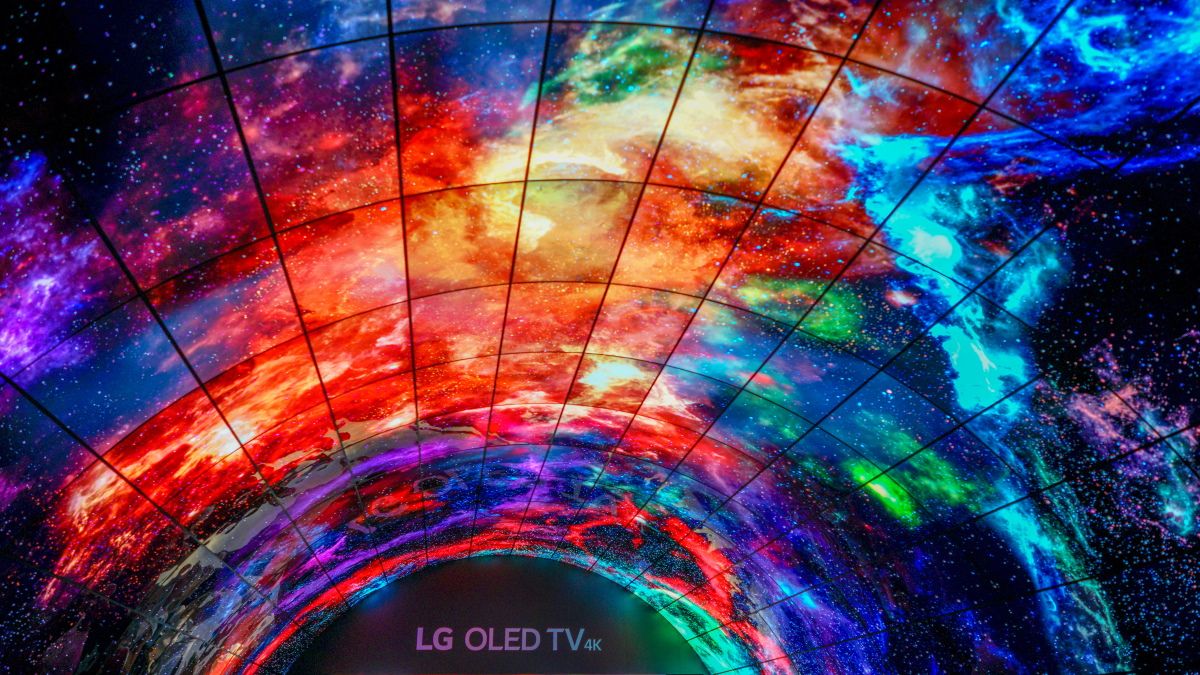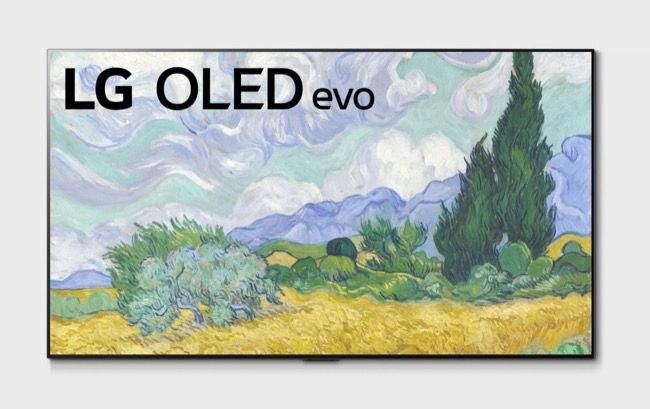Quick Links
If you're thinking of buying a new TV or smartphone, you might have seen the term "OLED" used to describe the type of display. So what exactly is OLED, what benefits does it have, and why should you choose it over other display technologies?
What Is OLED?
OLED stands for organic light-emitting diode or organic LED. To generate light or produce an image, an OLED display must pass an electrical current through organic electroluminescent material. Displays that can generate light without the need for a backlight are called "self-emissive" displays.
Self-emissive means that the organic materials used in construction generate light without any need for additional backlighting. This is different from other types of displays like LCDs, which require a separate light at the back of the display stack. Not all OLED implementations are alike, but all of them share the same basic concept of using non-synthetic materials to generate light.
While OLED is most commonly associated with high-quality displays, other uses include lighting, smaller display panels on car stereos or digital cameras, and signage.
Where Is OLED Used?
The most common place that you'll find OLED technology is in display panels used to produce televisions or smartphones. TV manufacturers like LG, Sony, and Panasonic have been producing OLED displays since the early 2010s, with significant developments in manufacturing helping to drive the cost down over the past decade.
OLED displays on smartphones have been common since the same period, with most new high-end smartphones like the iPhone 12 and Samsung Galaxy S21 using the technology. OLED screens are also present in smartwatches like the Apple Watch and the Samsung Galaxy Watch.
Some laptops and computer monitors also use OLED panels, though these are still quite rare due to the cost and other factors. Since the stack that makes up an OLED panel is so thin, OLED has been used to create innovative products like LG's rollable TVs, Samsung's foldable smartphones, fully transparent displays, and subway train windows that can display route information.
What Benefits Does OLED Have for TVs?
OLED displays have many benefits over traditional LED-lit LCDs. OLED panels are widely considered to produce a superior image when compared with LCD models thanks to a theoretically infinite contrast ratio.
Because OLED technology is self-emissive, each pixel can be turned off individually for "pure" black reproduction. Contrast ratio is a measure of the difference between the brightest white and the darkest dark that a display can reproduce, and is widely considered to be one of the most important factors when discussing image quality. You might hear reviewers say that the image "pops" on a display with a high or infinite contrast ratio.
On an LCD, a backlight must shine through the thin-film-transistor (TFT) layer to produce an image. When "black" is displayed, the panel must block as much light as possible, which often results in murky grays rather than true blacks.
Some TVs use zone-based algorithms in an attempt to dim certain parts of the display to achieve better black levels. While this works, it can have the effect of introducing halos or "ghosting" around areas that are lit up while causing black crush in areas that aren't lit up adequately. In modes designed for gaming where latency is reduced as much as possible, these algorithms might not dim the screen at all.
An OLED panel doesn't need local dimming features to produce a striking image since one pixel in the "off" state can sit right next to another that's operating at its maximum brightness.
Another reason that OLED panels are popular, particularly among gamers, is due to their very low pixel response times. Coupled with low-latency input optimization from display manufacturers like LG, OLED makes for excellent gaming displays. Just be aware that not all models support the HDMI 2.1 features required to get the most out of next-generation consoles like the Xbox Series X and PlayStation 5.
Finally, a tiny OLED stack means that OLED panels are incredibly thin, with far smaller bezels than those seen on most LCD models. This gives TVs that use OLED panels a striking, modern look.
How Does OLED Benefit Mobile Devices?
Smartphone and smartwatch manufacturers are increasingly turning to OLED panels for mobile devices, and power consumption has a lot to do with it.
Typically, an OLED display will use less power than a comparable LCD model due to the self-emissive nature of the underlying technology. When an OLED display is instructed to display pure black, the pixels are turned off. In this "off" state, these pixels don't draw any power.
If you have a smartphone or other mobile device that uses an OLED display, using a dark theme or background image will drain the battery slower than using a light theme or colorful background picture. The more pixels that are in the "on" state, the more power the display draws.
OLED panels used in mobile devices take up less space, which means that manufacturers can make thinner devices or better use the space inside the chassis for other things. You'll get the same improvements in contrast ratio and overall image quality on a mobile device as you would on a standard TV.
Unfortunately, OLED panels are still more expensive than their cheaper LCD counterparts, so self-emissive panels are generally only found on high-end devices.
Are There Any Drawbacks to OLED?
No technology is perfect, and OLED is no exception. The biggest concern surrounding OLED panels is one of permanent image retention, also known as "burn-in." This occurs when the same static image is displayed onscreen for an extended period.
Burn-in is cumulative, which means that watching the same image for 100 hours straight has the same effect as exposing the display to that same static image for one hour a day for over 100 days. On the latest panels, burn-in should only appear after hundreds (maybe thousands) of hours of the same image being displayed. There are many real-world tests that show this, like the RTINGS OLED torture test.
Because the materials used to generate light are organic, and organic substances degrade over time, OLED panels will get dimmer as they age. LG Electronics currently rates its panels for 100,000 hours, while original panels produced in 2013 or earlier were only rated for 36,000 hours.
The phenomenon known as "burn-in" refers to the uneven wear of pixels across the display. For example, when a red bar is displayed at the bottom of the screen for an extended period, the organic compound associated with that red sub-pixel is worn down at a different rate to the blue or green sub-pixels alongside it.
There are strategies designed to mitigate burn-in risk. LG Display has tweaked the sub-pixel structure of its displays over the years to combat this. Testing by reviewers suggests that most users have a low risk of ever encountering permanent image retention through normal, varied use of their televisions. But with that being said, the risk is ever-present.
There are also software solutions, like dimming algorithms used by most OLED TV manufacturers that reduce brightness in areas where a static image is displayed. This reduces wear since the organic compounds degrade at a slower rate. Pixel shifting, where the screen shifts the image to spread the load over a wider area, is also common.
The other main drawback of OLED technology is that current panels can't reach the same brightness as an LED-lit LCD. This makes OLED televisions more suited to darker environments, where subtle shadow details can be better appreciated. For a home cinema experience in a light-controlled room, OLED is unbeatable.
Despite having superior black reproduction to virtually any other technology currently on the market, OLEDs can have issues coming out of black. The jump from "off" to "on" can result in unsightly, near-black artifacts, particularly on low bitrate (heavily compressed) content.
Finally, there's the price. Since OLED panels have a more involved manufacturing process, they cost more than their LCD counterparts. You might find that a comparably feature-rich 65" LCD will cost around the same as a 55" OLED model, with high-end OLEDs from the likes of Panasonic and Sony costing considerably more.
Is OLED Right for You?
If you value image quality above all else, you should at least consider getting an OLED television. There are many questions that you should ask yourself when buying a TV, including:
- What is your budget?
- How bright is the room that you'll be watching TV in?
- What sort of content will you be watching?
- Are gaming features like VRR important to you?
- Will you be using a separate soundbar or receiver for audio?
There are many instances in which an OLED won't make sense, like in a brightly lit room that's used for watching rolling news channels all day. But for your home cinema or gaming den, an OLED might just knock your socks off.
Still confused? Answering a few basic questions can help you buy the perfect TV.





